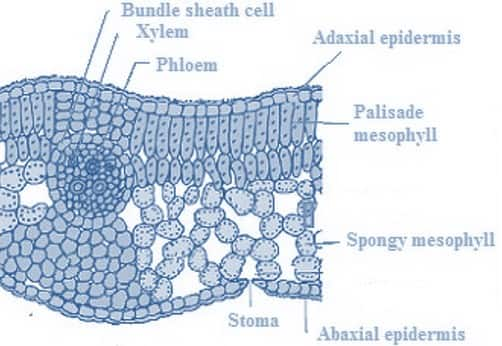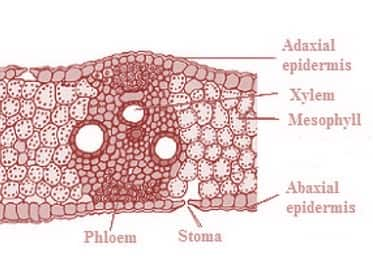NCERT Exemplar Class 11 Biology Solutions Chapter 6 Anatomy of Flowering Plants
The NCERT Exemplar Class 11 Biology Solutions Chapter 6 Anatomy of Flowering Plants explores the inner structure of plants. It includes different types of tissues and their functions that they perform. All these structures are well-explained with the help of labelled diagrams. The NCERT Exemplar includes detailed solutions to all questions, such as MCQs, short questions, and long questions. The Anatomy of Flowering Plants is a useful resource for students aiming for school examinations and competitive entrance exams like NEET.
This Story also Contains
- Find Answers to the NCERT Exemplar Class 11 Biology Chapter 6 (Multiple Choice Questions)
- Access Answers to NCERT Exemplar Class 11 Biology Solutions Chapter 6 (Very Short Answer)
- Detailed Answers to Anatomy of Flowering Plants Class 11 NCERT Exemplar
- Approach to Solve Questions of Class 11 Biology Chapter 6 Anatomy of Flowering Plants
- Main topics of NCERT Exemplar Class 11 Biology Solutions Chapter 6
- Advantages of NCERT Exemplar Class 11 Biology Chapter 6 Solutions
- Important Question from Anatomy of Flowering Plants Class 11 NCERT Exemplar
- NCERT Exemplar Class 11 Biology Solutions Chapter Wise
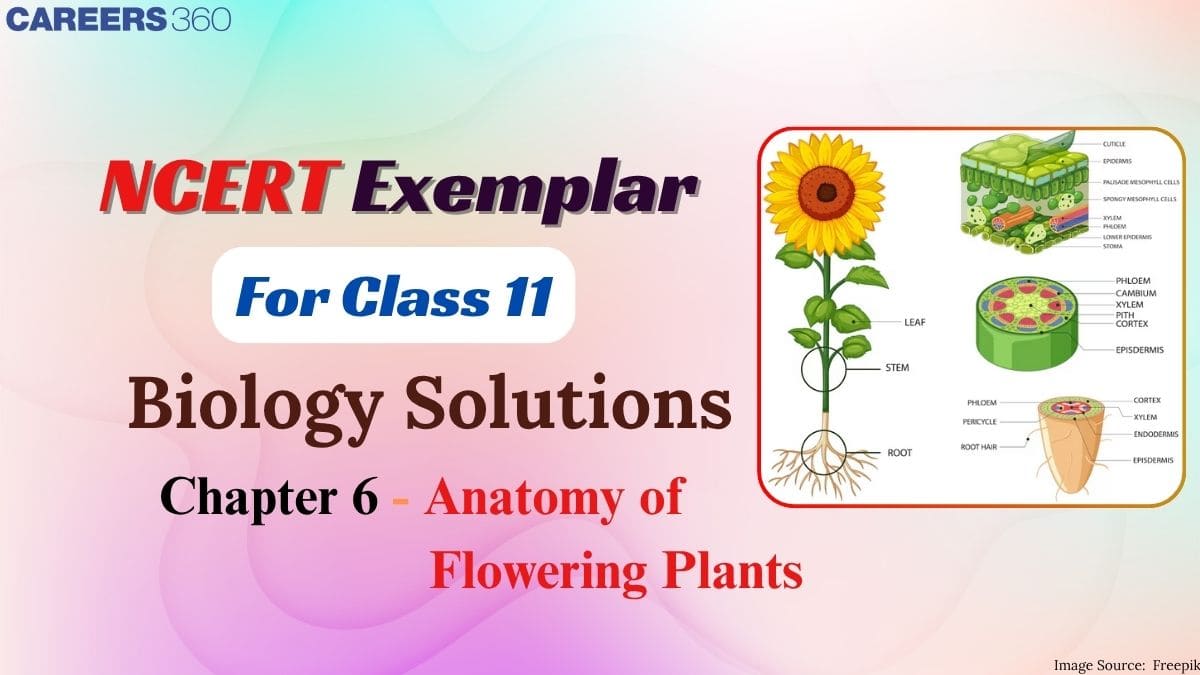
Through the NCERT Exemplar Class 11 Biology Solutions Chapter 6, students learn about the anatomy of monocot and dicot plants, and their vascular tissues (xylem and phloem). Various meristematic and permanent tissues, and secondary growth are also added. By doing the regular practice of the Anatomy of Flowering Plants Class 11 NCERT Exemplar, students can easily solve the problems without any confusion. The solutions give clarity on difficult concepts, helping students to prepare well for exams and become confident.
Find Answers to the NCERT Exemplar Class 11 Biology Chapter 6 (Multiple Choice Questions)
Different types of questions, such as MCQs, short answers, and long answers, are given to help students check their understanding of the chapter. Practising the NCERT Exemplar Class 11 Biology Chapter 6 also improves time management and helps in writing better answers during exams.
Question: 1
Red and green
Green and red
Orange and yellow
Purple and orange
Answer:
The answer is option (a), Red and green
Explanation: Xylem is coloured red with safranin because the walls of the xylem cells contain lignin, which picks up the red dye of safranin, and phloem is coloured green with fast green because fast green stains the dense cytoplasm and cell walls present in the phloem.
Question: 2
Match the following and choose the correct option from below
Column A | Column B |
A. Meristem | (i) Photosynthesis, storage |
B. Parenchyma | (ii) Mechanical support |
C. Collenchyma | (iii) Actively dividing cells |
D. Sclerenchyma | (iv) Stomata |
E. Epidermal tissue | (v) Sclereids |
Answer:
A. Meristem: It includes a group or cluster of cells that remain in a continuous state of division or retain their power of division.
B. Parenchyma: It performs the function of storage of reserve food materials, storage of water in succulents, Buoyancy, and gaseous exchange in water plants.
C. Collenchyma: It is the main supporting tissue in young dicotyledonous stems. Tissue has the capacity to expand and gives tensile strength to the body.
D. Sclerenchyma: It consists of thick-walled dead cells. It is of two main types: Fibres and Sclereids. Sclereids are short and possess extremely thick, lamellated lignified walls with long, tubular, simple pits.
E. Epidermal tissue: The tissue originates from the outermost layer of the apical meristem. It has an epidermis, cuticles and wax, Stomata, and Trichomes. The singular of stomata is stoma. A typical stoma is microscopic and usually consists of two kidney-shaped guard cells surrounding a pore.
So, the correct answer is 'A-(iii), B-(i), C-(ii), D-(v), E-(iv)'.
Question: 3
Match the following and choose the correct option from below
Column A | Column B |
A. Cuticle | (i) Guard cells |
B. Bulli form cells | (ii) Single-layer |
C. Stomata | (iii) Waxy layer |
D. Epidermis | (iv) Empty colourless cell |
Options:
(a) A-(iii), B-(iv), C-(i), D-(ii)
(b) A-(i), B-(ii), C-(iii), D-(iv)
(c) A-(iii), B-(ii), C-(iv), D-(i)
(d) A-(iii), B-(ii), C-(i), D-(iv)
Answer:
The answer is the option (a) A-(iii), B-(iv), C-(i), D-(ii)
Explanation:
A- Cuticle provides a waxy layer to the epidermis of the leaves for protection.
B- Bulli form cells are large, empty, and colourless epidermal cells.
C- Stomata a guard cells as they help in gas exchange.
D- The Epidermis is a single layer of cells in a plant
Question: 4
Identify the simple tissue from among the following
Parenchyma
Xylem
Epidermis
Phloem
Answer:
The answer is option (a), Parenchyma
Explanation: Parenchyma is a simple tissue as it contains one kind of cell, while the others are complex tissues as they contain more than one type of cell.
Question: 5
Xylem
Sclerenchyma
Collenchyma
Epidermis
Answer:
The answer is option (c), Collenchyma
Explanation: Xylem has mostly dead cells (except xylem parenchyma), but collenchyma cells are living and provide support with thickened corners
Question: 6
A conjoint and open vascular bundle will be observed in the transverse section of
Monocot root
Monocot stem
Dicot root
Dicot stem
Answer:
The answer is option (d), the Dicot stem
Explanation: Vascular bundles present in dicot stems are conjoint and open, unlike in other monocot stems, roots, and dicot roots.
Question: 7
Interfascicular cambium and cork cambium are formed due to
Cell division
Cell differentiation
Cell dedifferentiation
Redifferentiation
Answer:
The answer is option (c) Cell dedifferentiation
Explanation: The Process leading to the maturation of plants is differentiation. When differentiated cells regain their capacity for cell division, the phenomenon is called dedifferentiation. The formation of interfascicular cambium and cork cambium is an example of cell dedifferentiation from fully matured/differentiated parenchyma cells.
Question: 8
Phellogen and Phellem, respectively, denote
Cork and cork cambium
Cork cambium and cork
Secondary cortex and cork
Cork and secondary cortex
Answer:
The answer is option (b) Cork cambium and cork
Explanation: Cork cambium or phellogen is formed in the cortex region, and phellogen differentiates into cork or phellem.
Question: 9
In which of the following pairs of parts of a flowering plant is the epidermis absent?
Root tip and shoot tip
Shoot bud and floral bud.
Ovule and seed
Petiole and pedicel
Answer:
The answer is option (a) Root tip and shoot tip
Explanation: Root tips and shoot tips have meristematic cells, and epidermis is absent in them.
Question:10
26
1
5
30
4
Answer:
The answer is option (c) 5
Explanation: Five shoot apical meristems are generally present in a twig of a plant having 4 branches and 26 leaves. Four tips are present in the branches, and one at the tip.
Question:11
A piece of wood having no vessels (trachea) must belong to
Teak
Mango
Pine
Palm
Answer:
The answer is option (c) Pine
Explanation: Vessels are present in angiosperms and absent in gymnosperms, and hence, Pine is a gymnosperm and the correct answer.
Question:12
Collenchyma
Sclerenchyma
Xylem
Meristem
Answer:
The answer is option (a) Collenchyma
Explanation: Collenchyma cells have depositions of cellulose, pectin, and hemicellulose.
Question:13
In conifers, fibres are likely to be absent in
Secondary phloem
Secondary Xylem
Primary phloem
Leaves
Answer:
The answer is option (b) Secondary Xylem
Explanation: Elongated cells that are present in sclerenchyma are called fibres. Sclerenchyma is absent in secondary xylem; hence, fibres are absent as well.
Question:14
When we peel the skin of a potato tuber, we remove
Periderm
Epidermis
Cuticle
Sapwood
Answer:
The answer is option (a) Periderm
Explanation: Periderm, because the potato is a modified stem, and the outermost layer of the stem is a periderm.
Question:15
A vessel-less piece of stem possessing prominent sieve tubes would belong to
Pinus
Eucalyptus
Grass
Trochodendron
Answer:
The answer is option (d) Trochodendron
Explanation: Pinus and grass are gymnosperms and, therefore, do not contain sieve tubes, while eucalyptus contains vessels. Trochodendron contains sieve tubes but lacks vessels.
Question:16
Which one of the following cell types always divides by anticlinal cell division?
fusiform initial cells
root cap
protoderm
phellogen
Answer:
The answer is option (c) protoderm
Explanation: The Protoderm cell divides by anticlinal cell division, unlike others.
Question:17
What is the fate of the primary xylem in a dicot root showing extensive secondary growth?
It is retained in the centre of the axis.
It gets crushed
May or may not get crushed
It gets surrounded by primary phloem.
Answer:
The answer is option (a). It is retained in the centre of the axis
Explanation: The Primary xylem is retained in the centre of the axis, while the primary phloem is crushed.
Question:18
What is the fate of the primary xylem in a dicot root showing extensive secondary growth?
It is retained in the centre of the axis.
It gets crushed
May or may not get crushed
It gets surrounded by primary phloem.
Answer:
The answer is option (a). It is retained in the centre of the axis
Explanation: The Primary xylem is retained in the centre of the axis, while the primary phloem is crushed.
Access Answers to NCERT Exemplar Class 11 Biology Solutions Chapter 6 (Very Short Answer)
The answers to the short-answer questions are given below:
Question:1
Answer:
Food gets stored in parenchymatous cells that are present either in the stems or the roots
Question:2
Answer:
If the protoxylem lies next to the phloem, the arrangement is called an exarch. This arrangement can be found in the roots.
Question:3
What is the function of phloem parenchyma?
Answer:
The primary function of phloem parenchyma is the storage of food and transportation of food. It also helps in storing other substances like latex and resins.
Question:4
Answer:
The cuticle is the waxy layer that is present on the leaves, which prevents the loss of water. The cuticles are absent in the roots.
Question:5
What is the epidermal cell modification in plants that prevents water loss?
Answer:
Bulliform cells help in the rolling and unrolling of leaves, thereby reducing water loss during stress.
Question:6
What part of the plant would show the following:
Radial vascular bundle
Polyarch xylem
Well-developed pith
Answer:
(a) The radial vascular bundle is available in roots.
(b) Polyarch xylem is available in monocot roots.
(c) A well-developed pith can be found in dicot stems and monocot roots.
Question:7
What are the cells that make the leaves curl in plants during water stress?
Answer:
Bulliform cells help in the rolling and unrolling of leaves, thereby reducing water loss during stress.
Question:8
What constitutes the cambial ring?
Answer:
The cambial ring is a ring of cambium that is made together of interfascicular and intrafascicular cambia.
Question:9
Give one basic functional difference between phellogen and phelloderm.
Answer:
Phellogen consists of meristematic cells, whereas phelloderm is a permanent tissue made up of permanent cells.
Question:10
Answer:
Phellem is the outermost layer, followed by Phellogen and then Phelloderm.
Question:11
If one debarks a tree, what parts of the plant are being removed?
Answer:
Bark consists of cork, cork cambium, secondary cortex, and secondary phloem. If one debarks a tree, these parts will be removed.
Question:12
The vascular bundles were radially arranged.
Four xylem strands with an exarch condition of protoxylem.
To which organ should it be assigned?
Answer:
In roots, vascular bundles are radially arranged, and the four xylem strands are arranged with an exarch condition.
Question:13
What do hardwood and softwood stand for?
Answer:
Dicot angiospermic wood is called hardwood, and gymnosperm wood is called softwood.
Question:14
Answer:
While eating a peach or a pear, it is usually seen that the entanglement in the teeth is called a stone cell. Stone cells are a type of sclerenchyma cell.
Question: 15
What is the commercial source of cork? How is it formed in the plant?
Answer:
The commercial source of cork is Quercus suber. Cork is formed from phellogen or cork cambium, which is formed as secondary meristem due to dedifferentiation.
Question: 16
Below is a list of plant fibres. From which part of the plant are these obtained
(a) Coir (b) Hemp (c) Cotton (d) Jute
Answer:
a) Coir is obtained from the outer coating of a coconut seed
b) Hemp is obtained from the stem of the Cannabis sativa plant
c) Cotton is obtained from cotton boll seeds
d) Jute is obtained from the stem of the jute plant
Question: 17
What are the characteristic differences found in the vascular tissue of gymnosperms and angiosperms?
Answer:
The differences between vascular tissues of gymnosperms and angiosperms are the following:
Vessels are absent in the xylem of gymnosperms, which is not the case for angiosperms.
Companion cells are not present in the phloem of gymnosperms, but are present in the phloem of angiosperms.
Question: 18
Answer:
Some of the modifications of epidermal cells and their functions are-
Root hair helps in absorbing water and important minerals for the plant.
Stinging hair (trichomes) protects the plant from the physical environment.
Question: 19
Answer:
The intercalary meristem in grasses allows rapid regrowth after mowing, leading to a bushy appearance. When grass is mowed, the apical layer is removed, which gives way to the growth of lateral branches which was obstructed by the apical buds. This makes the grass bushier.
Question: 20
Plants require water for their survival. But when watered excessively, plants die. Discuss.
Answer:
Ans. Water is a necessary element for the survival of a plant. But excessive watering can lead to its death because excess water replaces the air, and there is a lack of oxygen for respiration, leading to the death of plant cells.
Question: 21
Answer:
Growth rings are formed from meristematic tissue of the cambium in dicot trees. Cambium is very active in the spring season, leading to the formation of a large number of xylary elements having wider vessel cavities. This wood is called springwood. In winter, the cambium activity is slowed down, leading to fewer xylary elements with narrower vessel cavities. The wood is called latewood or autumn wood.
The two kinds of wood appear together with concentric rings known as annual rings or growth rings. These rings give an estimated age of a tree.
Question: 22
Answer:
It is a case of anatomical abnormality, which is due to abnormal secondary growth caused by the abnormal positioning of meristematic tissue cambium. Sometimes in aged trees, the abnormal secondary growth produces extravascular bundles, which lead to the growth of fused trunks.
Question: 23
What is the difference between lenticels and stomata?
Answer:
Lenticels | Stomata |
(i) These are aerating pores found in the bark or stems of plants. | (i) These are cell structures in the epidermal layers of leaves and stems. |
(ii) Guard cells do not surround lenticels. | (ii) Guard cells surround the stomata. |
(iii) Unregulated opening of the lenticels. | (iii) Regulated opening of the stomata. |
(iv) Helps in the removal of waste. | (iv) Helps in gas exchange. |
Question: 24
Write the precise function of
(a) Sieve tube (b) Interfascicular cambium
(c) Collenchyma (d) Aerenchyma
Answer:
Transportation of synthesised food.
It helps in secondary growth.
It provides mechanical support to herbaceous stems.
It helps hydrophytes in facilitating buoyancy.
Question: 25
Answer:
The epidermal cells surrounding the guard cells are called subsidiary cells. The following are the differences between guard cells and epidermal cells.
Guard Cells | Epidermal Cells |
(i) Guard cells are bean or kidney-shaped. | (i) Epidermal cells are barrel-shaped. |
(ii) Chloroplasts are present in guard cells. | (ii) Epidermal cells lack chloroplasts. |
(iii) Guard cells are smaller. | (iii) Epidermal cells are bigger. |
(iv) Thick and non-uniform cell walls are present in guard cells. | (iv) Thin and uniform cell walls are present in epidermal cells. |
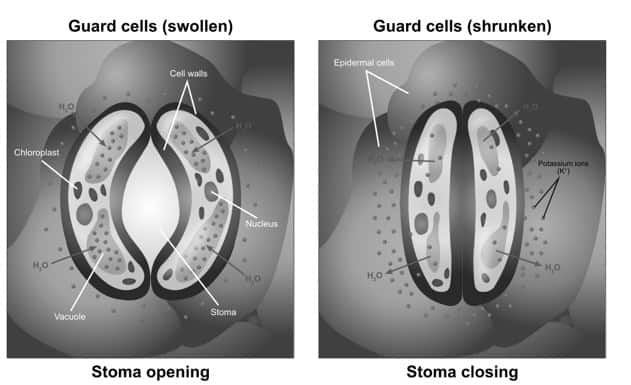
Question: 26
Answer:
Ficus leaf | Maize leaf |
(i) A Ficus leaf is a dorsiventral leaf. | (i) Maize leaf is an isobilateral leaf. |
(ii) Stomata are found in the lower epidermis region of the leaf. | (ii) Stomata are found in both upper and lower epidermis regions of the leaf. |
(iii) Mesophyll cells are differentiated into spongy and palisade cells. | (iii) Mesophyll consists of only spongy cells. |
(iv) It lacks bulliform cells. | (iv) It consists of bulliform cells. |
|
|
Question: 27
The palm is a monocotyledonous plant, yet it increases in girth. Why and how?
Answer:
Palms are monocots, but they increase girth by diffuse secondary growth. Parenchyma and ground meristem undergo cell division and enlargement, causing stem thickening.
Detailed Answers to Anatomy of Flowering Plants Class 11 NCERT Exemplar
Question:1
Answer:
The placenta is soft tissue to which the ovules are attached. It is found in the inner ovary wall. The arrangement of ovules inside the ovary is called placentation. Placentation can be of different types like marginal, basal, parietal, axile, and free central placentation. In the marginal one, a ridge kind of structure is formed between the placenta and the ovary. The ovules are arranged on this ridge in two rows, for example, pea. In basal one, the placenta is formed at the lower region of the ovary. Only a single ovule is attached to the placenta: example- sunflower. In parietal one, the ovules are attached to the inner wall of the ovary or in the peripheral area in two chambers, for example, mustard. In axile placentation, the ovules develop in the central axis in a multilocular ovary, for example, the tomato. In free central placentation, the ovules develop along the central axis, but in a unilocular ovary, for example, primrose.
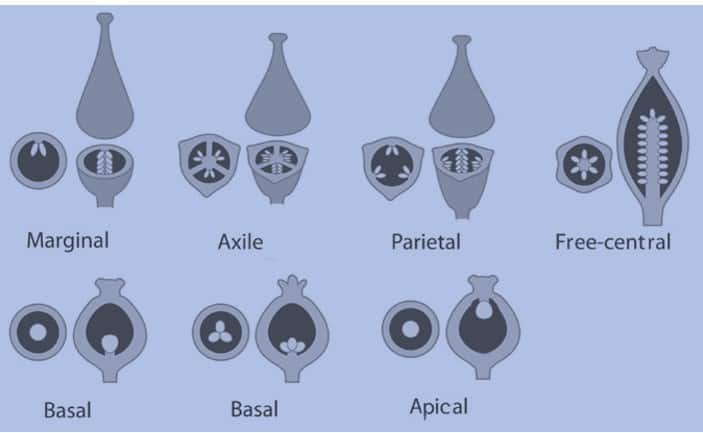
Question: 2
Answer:
Shedding of leaves in plants is known as abscission of leaves. Apart from physiological changes, anatomical changes are also involved in the shedding of leaves.
Some anatomical changes are –
1. Formation of an abscission zone, also known as a separation zone, at the base of the petiole in deciduous trees. This zone is made up of a weak top layer and a bottom layer. In the autumn, the bottom layer expands, breaking the cells of the top layer, which allows the leaf to shed.
2. Excess loss of chlorophyll can also be attributed to the falling of the leaves.
3. Hormonal change can also occur in deciduous trees due to the excess secretion of abscisic acid, which stimulates the process of abscission.
The abscission zone is also called the separation zone. It is formed at the base of the petiole. It is composed of a top layer and a bottom layer. The cells in the top layer have weak cell walls. The bottom layer expands in winter and breaks the cell walls of the top layer. This results in the shedding of leaves.
Question:3
Is Pinus an evergreen tree? Comment.
Answer:
Pinus is not a deciduous tree because it does not shed its leaves in any particular season. It is an evergreen tree because it has leaves throughout the year, and the leaves shed throughout the year and grow back. This is because Pinus trees have thicker cuticles and sunken stomata that reduce the loss of water, helping them to grow leaves throughout the year.
Question: 4
Answer:
A plant cell can be cut transversely, longitudinally, or obliquely. Depending on the plane, we can study T.S., L.S., and radial views.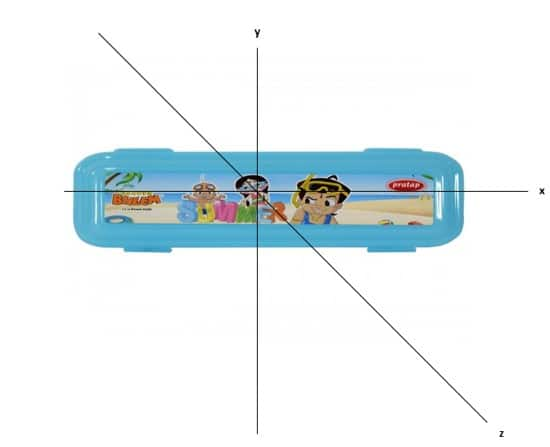
Question: 5
Plasmadesmoses/ Plasmodesmata
Middle lamella
Secondary wall
Answer:
(a) Plasmodesmata are channels that directly connect the cytoplasm of one plant cell to another. It helps in establishing communication and transportation of food and other important minerals from one plant cell to another.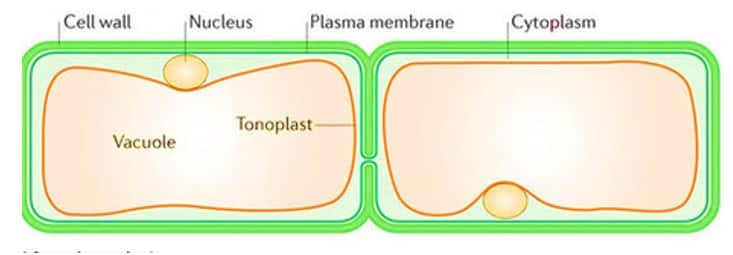
(b) The middle lamella consists of pectin, which acts as a glueing agent, helping in holding the cell walls of two adjacent cells together.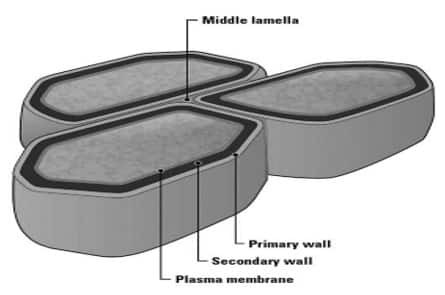
(c) Secondary walls are composed of cellulose, lignin and hemicellulose, which provide strength to the plant and protect it from any mechanical stress.
Question: 6
Distinguish between the following:
(a) Exarch and endarch condition of protoxylem
(b) Stele and vascular bundle
(c) Protoxylem and metaxylem
(d) Interfascicular cambium and intrafascicular cambium
(e) Open and closed vascular bundles
(f) Stem hair and root hair
Answer:
(a) Endarch is a protoxylem condition that occurs in the stem of a plant when the protoxylem is arranged in the centre and the metaxylem is arranged at the periphery of the stem. Exarch is a protoxylem condition that occurs in the roots of a plant. In this, the protoxylem lies at the periphery, and the metaxylem is arranged in the centre. This arrangement is called the exarch.
(b) The stele comprises the major part of the root and stem. A stele consists of the vascular bundles, pericycle and the pith. The vascular bundle is a part of the stele consisting of xylem and phloem types of complex tissues.
(c) There are two kinds of primary xylem- protoxylem and metaxylem. The primary xylem, which formed earlier and is smaller in size, is the protoxylem, and the one which is formed later and is larger in size is called the metaxylem.
(d) In dicot stems, the cambium cells that are present between the primary xylem and primary phloem are called the intrafascicular cambium, whereas the interfascicular cambium is formed by the adjoining medullary cells with the intrafascicular cambium. This meristematic form is the interfascicular cambium.
(e) A closed vascular bundle is one which lacks cambium and, therefore, cannot perform secondary growth, whereas an open vascular bundle is one which has cambium and can very well perform secondary growth.
(f) Stem hairs are trichomes that grow on stems. Trichomes are multicellular epidermal cells, and these can be branched or unbranched and soft or rigid. These protect plants from physical dangers and also help in preventing much loss of water. Root hairs are unicellular epidermal cells present in the roots of plants. Root hairs help in absorbing water and important minerals from the soil for the growth of the plant.
Also, check the NCERT Books and NCERT Syllabus here
Approach to Solve Questions of Class 11 Biology Chapter 6 Anatomy of Flowering Plants
The students should begin by understanding the tissue systems, meristematic and permanent tissues, and their types and functions. They should give attention to diagrams of transverse sections of roots, stems, and leaves of both monocots and dicots. Labelling and identification of various parts is important to understand features like vascular bundle arrangement, presence of cambium, and secondary growth. Students should have clear conceptual clarity and visual memory. Regular revision and solving the Anatomy of Flowering Plants Class 11 NCERT Exemplar will boost confidence during the exams.
Also, read the NCERT Solution subject-wise
Main topics of NCERT Exemplar Class 11 Biology Solutions Chapter 6
This chapter helps students to understand how different parts of a plant are built from the inside and how their internal structures support various functions. Given below are the important topics and questions about them that are covered in the NCERT Exemplar Class 11 Biology Solutions Chapter 6.
Tissues: meristematic and permanent tissues
Simple and complex permanent tissues
Anatomy of dicot and monocot roots and stems
Secondary growth in dicots
Vascular cambium and cork cambium
Functions of different plant tissues
NCERT Exemplar Class 11 Solutions
Advantages of NCERT Exemplar Class 11 Biology Chapter 6 Solutions
Anatomy of Flowering Plants introduces students to the secondary growth of roots, stems, and the vascular structures found in plants. Solving the exemplar problems after going through the chapter makes the preparation effective.
- NCERT Exemplar Class 11 Biology Chapter 6 Solutions provides well-structured answers to all the questions related to the anatomy of plants.
- Students will understand how to write answers in the exam, along with the well-labelled diagrams.
- Regular practice of the exemplar problems gives them knowledge about the anatomy of dicot and monocot roots and stems.
- The exemplar solutions also encourage self-assessment through different types of questions, such as MCQs, short and long answers. These types of questions are commonly asked in the board exams and competitive exams like NEET.
- Solving the exemplar problems improves problem-solving skills and boosts confidence.
Important Question from Anatomy of Flowering Plants Class 11 NCERT Exemplar
This question helps the students to test their understanding of the internal structure and function of plant parts. For more questions, students can use the Anatomy of Flowering Plants Class 11 NCERT Exemplar.
Question 1: Tracheids differ from other tracheary elements in
Options:
having Casparian strips
being imperforate
lacking a nucleus
being lignified
Answer:
Tracheids and vessels are both called tracheary elements because their main function is the conduction of sap. Tracheids differ from other tracheary elements in being imperforate. Tracheids are the specific cells that have pits to support upward and lateral conduction of water sap. These are comparatively short and single-cell, while vessels have more than one cell and are up to 10 cm long.
Hence, the correct answer is option (2), being imperforate
Question 2. Which meristem is responsible for the increase in the girth of dicot stems and roots?
Options:
Apical meristem
Intercalary meristem
Vascular cambium
Cork cambium
Answer:
In dicot stems and roots, the vascular cambium is a lateral meristem that produces secondary xylem towards the inside and secondary phloem towards the outside, leading to an increase in the thickness or girth of the organ.
Hence, the correct answer is option (3) Vascular cambium.
Question 3. Which one of the following cell types always divides by anticlinal cell division?
Option 1. Fusiform initial cells
Option 2. Root cap
Option 3. Protoderm
Option 4. Phellogen
Answer :
Anticlinal cell division, a type of cell division in which the cells divide perpendicular to the surface, is how protoderm cells proliferate, increasing the plant's surface area. This kind of cell division is different from others, such as periclinal division, which thickens the tissue by dividing cells parallel to the surface.
Hence, the correct answer is option (3) protoderm
Must Read NCERT Notes subject-wise
NCERT Exemplar Class 11 Biology Solutions Chapter Wise
The chapter-wise solutions are given below for easy and quick access:
Frequently Asked Questions (FAQs)
Anatomy of plants is a major chapter that is part of the entrance exam syllabus, and thus, understanding NCERT questions and answers will help in solving MCQs in a better way.
Yes, these questions in the exercise are mentioned with complete detail in the easiest language and with illustrative diagrams.
The major tissue types include:
Meristematic Tissue – Actively dividing cells for plant growth.
Permanent Tissue – Differentiated cells forming simple (parenchyma, collenchyma, sclerenchyma) and complex (xylem, phloem) tissues.
Xylem transports water and minerals from roots to other parts and provides mechanical support.
Phloem transports organic nutrients (sugars) from leaves to other plant parts, supporting growth and storage.
This NCERT Exemplar Class 11 Biology Solutions Chapter 6 Anatomy of Flowering Plants covers all the crucial topics like xylem, phloem, vascular cambium, cork cambium, secondary growth in roots, etc.
Secondary growth in dicot stems occurs due to the activity of vascular cambium and cork cambium according to the NCERT Exemplar Class 11 Biology Solutions Chapter 6 Anatomy of Flowering Plants. Vascular cambium forms secondary xylem (wood) and secondary phloem, while cork cambium develops periderm (protective outer layer), increasing the stem’s thickness.
NCERT Exemplar Class 11 Biology Solutions Chapter 6 Anatomy of Flowering Plants provides conceptual questions, diagrams, and explanations that help students grasp the structure and function of plant tissues, their organization in different plant parts, and the process of secondary growth, enhancing problem-solving skills.
Dicot stems have a ring-arranged vascular bundle, distinct pith, and undergo secondary growth, whereas monocot stems have scattered vascular bundles, a large ground tissue, and lack secondary growth due to the absence of vascular cambium.
Popular Questions
Courses After 12th
Applications for Admissions are open.
As per latest syllabus. Physics formulas, equations, & laws of class 11 & 12th chapters
JEE Main Important Chemistry formulas
Get nowAs per latest syllabus. Chemistry formulas, equations, & laws of class 11 & 12th chapters
JEE Main high scoring chapters and topics
Get nowAs per latest 2024 syllabus. Study 40% syllabus and score upto 100% marks in JEE
JEE Main Important Mathematics Formulas
Get nowAs per latest syllabus. Maths formulas, equations, & theorems of class 11 & 12th chapters
